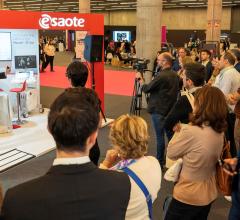
July 16, 2013 — The first-ever presentation at a medical conference using hologram technology instead of traditional video projection screen took place July 1 at the American Society of Echocardiography’s (ASE) 2013 scientific sessions. Partho P. Sengupta, MBBS, M.D., DM, FASE, director of cardiac ultrasound research and associate professor of medicine in cardiology at the Mount Sinai Medical Center in New York, conducted the live display of free-floating 3-D holograms, some 10 feet tall, on stage before a crowd of 1,000 echocardiography experts. The innovative presentation was used to drive home the advances in technology that are going to completely reshape cardiac ultrasound and medical imaging over the next few years.
Sengupta beamed on stage with him holograms of projected 3-D digital images, animation and expert interview recordings to illustrate the latest technology and future applications of functional echocardiography to more precisely analyze the structure, function and flow patterns of the cardiovascular system. The presentation included rotating 3-D anatomy created from cardiac ultrasound and a life-sized holographic recording of Sengupta's mentor, who appeared on stage and had a conversation with him.
The innovative holographic presentation was made possible through the unique, collaborative efforts of engineering and animation experts from around the world including from the United States, India, Europe and Canada.
“We are so very proud at Mount Sinai of Dr. Sengupta’s first-of-its-kind, innovative holographic presentation,” says Valentin Fuster, M.D., Ph.D., director of Mount Sinai Heart, physician-in-chief, director of the Zena and Michael A. Wiener Cardiovascular Institute, and the Marie-Josée and Henry R. Kravis Center for Cardiovascular Health at the Mount Sinai Medical Center. “Dr. Sengupta is a true leader in the field of cardiac imaging and is advancing the detection of cardiovascular disease in patients at its earliest stages — when it matters the most for successful prevention and intervention.”
“Dr. Sengupta’s presentation was nothing short of remarkable," said Neil J. Weissman, M.D., FASE, 2014-15 president-elect for ASE, who serves as president of MedStar Health Research Institute and professor of medicine at Georgetown University School of Medicine. "It will go down in the history of the ASE scientific sessions for both its powerful message and impactful presentation media.”
Similar mid-air holographic projections are being developed for use in the cath lab, where 3-D cardiac anatomy can be sliced and rotated to specific orientations to aid procedural navigation.





 August 27, 2024
August 27, 2024 









